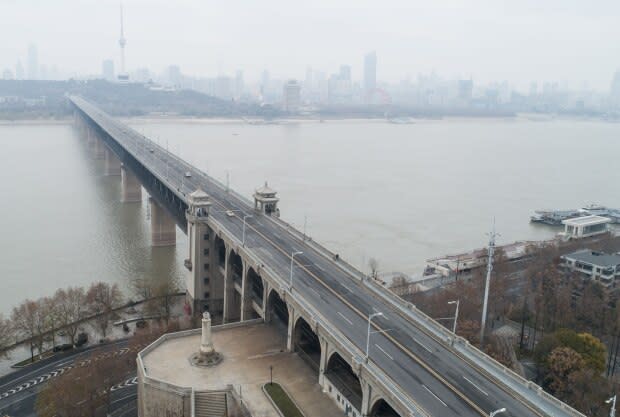Fallout from coronavirus outbreak triggers 25% decrease in China's carbon emissions
In the midst of China's COVID-19 epidemic, the conditions for an unprecedented climate experiment have emerged.
Climate researchers can measure in real time what happens to carbon emissions when one of the world's largest economies is suddenly stalled, with entire cities locked down, highways emptied, airplanes grounded, factories shuttered and millions of people confined to their homes.
A continent away, from his base in Helsinki, Finland, Lauri Myllyvirta was able to piece together industry and financial data sources and satellite imagery to calculate the epidemic's impact on emissions: a decrease of about 25% in three weeks.
"In terms of the absolute volume of emissions, this is absolutely unprecedented," he said.

As a climate analyst with the Centre for Research on Energy and Clean Air, Myllyvirta keeps a close eye on China's economic activity.
His analysis showed how reduced demand for coal from Chinese power plants combined with the slowing of production in oil refineries and steel plants created a decline in the country's major industrial sectors.
"In terms of global emissions, it's the biggest story of the year. There's no question about that," he said.

To support his analysis, he also studied satellite images of China's nitrogen dioxide (NO2) emissions, a pollutant that is emitted through the burning of fossil fuels.
"That actually showed an even larger reduction of around 35 per cent in NO2 levels, so it gave us confidence that we're at least not overestimating when we say 25 per cent or more," he said.
13,000 fewer flights a day
Another significant contributor to the emissions decrease was the dramatic decline in China's domestic and international air traffic, which account for about 15 per cent of global air travel emissions.
An analysis by the flight data agency Flightradar24 shows that since late January, 13,000 fewer flights are landing and taking off each day from Chinese airports.
"In general, air traffic originating in China is down 80 per cent since the beginning of the year," Flightradar24 spokesperson Ian Petchenik said in an email.

The paradox of airline travel is one of the most intriguing aspects of the epidemic for Ann Dale, director of the School of Environment and Sustainability at Royal Roads University in Victoria.
"We've got a virus that is spreading more rapidly because of our advances in airline travel. Ironically, it's also resulting in a decrease in that airline travel."
She said it raises questions about how much international travel is sustainable.
"What are the limits and optimal scale of travelling? How many greenhouse gas emissions do you want to consume?" she said.
"Maybe it's time we started addressing questions about limits and scale on human consumption."
An economic shock that affects carbon emissions this dramatically is rare. Experts point to the 2008 global financial crisis as another moment when an unintended series of circumstances resulted in major reductions in carbon emissions.
"What it shows is that emissions are closely linked to economic growth," said Klaus Hubacek, an ecological economist at the University of Groningen, Netherlands. "Once economic activities decline, you have a reduction of associated emissions."
'De-coupling' growth from carbon
The entanglement of economic activity and carbon emissions is one of the most vexing aspects of climate change mitigation.
For years, experts have debated how to separate growth from carbon emissions, a concept known as de-coupling.
"The economy grows, the emissions grow, unless we have decoupling," said Hubacek, whose research has shown that reducing carbon emissions in one country often results in a shift of carbon-intensive production to another country.
The task is also complicated by the challenge of lifting much of the world out of poverty while trying to reduce emissions. Hubacek points out that half of the world's population is still living on $3 a day.
Some academics are also studying the concept of degrowth, a school of thought where economic activity is deliberately reduced to slow climate change. The research is geared toward policies that would gradually scale back economic growth to the point where it's in sync with global resources. The idea is to use local resources and change the way people work so that less time is spent on economically oriented activity.
"I find it quite sympathetic and interesting but it's really, within academia, a niche. I don't think it has any political traction at this point," said Hubacek.

The various carbon mitigation strategies being considered around the world right now are based on a planned and co-ordinated approach to reducing emissions. So the empty highways and silent streets of Wuhan, China, are not some stark glimpse of a carbon-controlled future.
"Economic activity has to be reduced in some sectors and overall emissions have to decrease, but this is not in any way planned or a healthy way of reducing emissions," said Hubacek.
Myllyvirta had a similar assessment of what's happening in China.
"A plan to bring down emissions, even very rapidly, would not look like this," he said.
"Millions and millions of people are suffering in different ways because of what's happening in China. People are unable to access health care, people are unable to work. Many of them are losing income."

Having said that, some aspects of China's response to the coronavirus — such as the construction of Huoshenshan Hospital in Wuhan in just 10 days — could be used as a model if the world decided to move rapidly to a green economy, he said.
"It would look more like that construction site for the hospital, mobilizing a lot of resources to build clean energy on a scale that would enable us to ditch fossil fuels in the span of a decade or two."
Myllyvirta said his colleagues in China who have been forced to work from home during the epidemic have already adapted.
"I have so many friends and contacts who have logged on to a proper video conferencing system for the first time because of this," he said. "Will we see more remote working in China going forward? That's something that has been adopted very rapidly."
Rapid recovery could increase emissions
The climate implications of COVID-19 are still evolving. More flights are being cancelled as the epidemic spreads to other countries.
And the outbreak is already being factored into global oil demand projections.
The International Energy Agency's oil market report this month stated that "global oil demand has been hit hard" by the virus and China's economic slowdown. The report predicts demand will fall in "the first quarterly contraction in more than 10 years."
But those contractions in fossil fuel consumption are viewed as temporary. There are concerns that carbon emissions could rise sharply if China pushes for rapid economic recovery when the epidemic subsides.
Chinese officials could choose to stimulate the economy through large-scale, carbon-intensive construction projects as has happened in the past, said Myllyvirta.
"If [China] actually wants to grow the GDP six per cent after what's happened during the past few weeks, that would mean an enormous amount of spending on new construction. And that would mean a lot of emissions."
When the country raced to recover from the previous financial crisis by building infrastructure, the amount of emission-intensive cement used between 2011 and 2014 was staggering.
"In those three years, they consumed 50 per cent more cement than the U.S. in the whole of the 20th century," said Hubacek. "It's just mind-boggling."


